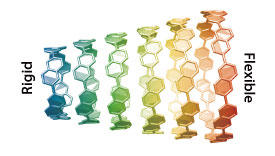

10/31/2016

© 2016 Hiroyuki Isobe
Stronger than steel, lighter than aluminum, more conductive than copper — carbon nanotubes boast some exceptional properties.
One key to these properties is the nanotube’s unique shape: a hollow cylinder of tightly bonded carbon atoms, across which a sea of electrons freely flows. To gain a deeper understanding of how the curved shape contributes to the properties of carbon nanotubes, AIMR researchers have synthesized a series of belt-shaped carbon ‘nanohoops’, which mimic the nanotube structure, but are shorter and simpler1. In creating these carbon structures, the team discovered that the nanohoops have a rich chemistry of their own.
Hiroyuki Isobe and his colleagues from the AIMR at Tohoku University made the series of nanohoops by combining flat carbon structures called arylenes. The arylenes join together to form a loop in a process akin to threading flat beads together to form a necklace. Using an approach called random synthesis, the team produced nanohoops ranging in size from six to eleven arylene units.
The researchers showed that the true structural diversity was considerably greater than just six nanohoops of different sizes. Each arylene ‘bead’ can attach to the growing nanohoop in two possible orientations, forming different structures known as stereoisomers. Teaming up with a mathematician, the researchers calculated the total number of possible stereoisomers that a nanohoop of any given size could have. These calculations predict that the largest, 11-arylene nanohoop can form 126 different stereoisomers.
More significantly for carbon nanotube research, the team used variable-temperature nuclear magnetic resonance (NMR) to show that the larger the nanohoop, the more flexible its structure becomes (see image). To be a good model for a carbon nanotube’s stiff cylindrical shape, rigid nanohoops are required. Of Isobe’s nanohoops, only the smallest, six-arylene nanohoops showed sharp peaks in the room-temperature NMR spectrum, which indicate the necessary rigid cylindrical structure.
“Our study is the first to show this threshold between rigid, cylindrical molecules and fluctuating molecules,” Isobe says. The team found that of the many structural variants of nanohoops that have been designed to mimic nanotubes, very few of them successfully mimic the persistent cylindrical shape of carbon nanotubes.
The work lays the foundations for further studying the unique structural chemistry of nanohoops. “This study shows that we are at a very fundamental, early stage of understanding the chemistry of these materials,” Isobe adds. “We are now trying to reveal the secrets hidden in the persistent cylindrical shape, and hope that many new surprises will enrich the chemistry and its allied areas.”
This research highlight has been approved by the authors of the original article and all information and data contained within has been provided by said authors.